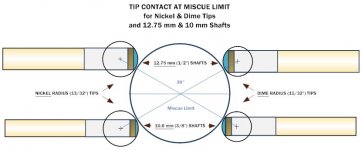Many years ago, played a guy at Starcher's in Akron. He was from somewhere in Northern Kentucky. Played with half a tip. No, part of the tip hadn't "flaked off". He purposely cut the tip with a knife. Never seen anything like that before or after the match. How does that compare with the OP's question about small tips?
Lyn
Thats very interesting. I wonder how that would affect CB squirt. That is removing end mass as close as possible to the cue ball. The leather is very light, compared to the wood/ferrule traditionally removed in low squirt shafts. But, this is RIGHT at the tip, literally. I always wondered how the ratio of mass removed compared to its distance from the tip affected CB squirt.

